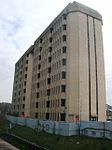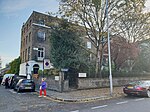West Kensington
West Kensington, formerly North End, is an area in the ancient parish of Fulham, in the London Borough of Hammersmith and Fulham, England, 3.4 miles (5.5 km) west of Charing Cross. It covers most of the London postal area of W14, including the area around Barons Court tube station, and is defined as the area between Lillie Road and Hammersmith Road to the west, Fulham Palace Road to the south, Hammersmith to the north and West Brompton and Earl's Court to the east. The area is bisected by the major London artery the A4, locally known as the Talgarth Road. Its main local thoroughfare is the North End Road. It is predominantly a dense residential area with the Queen's Club in its midst and is bordered by the Lillie Bridge railway depot, the now defunct Earls Court Exhibition Centre site, Olympia Exhibition Centre and the commercial centres at Fulham and Hammersmith Broadway.
Excerpt from the Wikipedia article West Kensington (License: CC BY-SA 3.0, Authors).West Kensington
North End Road, London West Kensington (London Borough of Hammersmith and Fulham)
Geographical coordinates (GPS) Address Website Nearby Places Show on map
Geographical coordinates (GPS)
| Latitude | Longitude |
|---|---|
| N 51.4907 ° | E -0.2065 ° |
Address
Famous 3 Kings
North End Road 171
W14 9NL London, West Kensington (London Borough of Hammersmith and Fulham)
England, United Kingdom
Open on Google Maps









